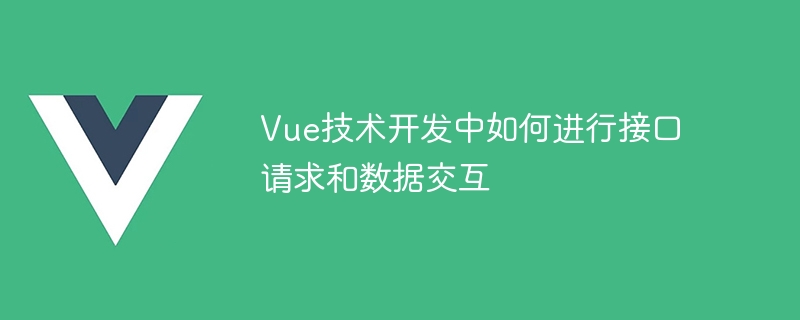Vue技術開發中如何進行介面請求和資料交互
- 王林原創
- 2023-10-08 12:01:072154瀏覽

Vue技術開發中如何進行介面請求和資料互動
引言:
在Vue技術的開發過程中,介面請求和資料互動是非常重要的一部分。介面請求用於從後端獲取數據,而數據互動則是前端頁面上的數據與後端數據的互動過程。本文將詳細介紹Vue技術中如何進行介面請求和資料交互,並附上具體的程式碼範例。
一、介面請求
介面請求是Vue開發中取得後端資料的重要方式。 Vue提供了axios和fetch等工具庫來進行介面請求。以下以axios為例,介紹如何進行介面請求。
-
安裝axios
將axios安裝到專案中,使用npm指令進行安裝:npm install axios --save
-
引入axios
在需要在使用介面請求的元件中,將axios引入:import axios from 'axios';
-
發送介面請求
透過axios發送介面請求,可以使用axios的get、post、put和delete等方法。以下以get請求為例:axios.get('/api/user') .then(function (response) { console.log(response); }) .catch(function (error) { console.log(error); });在上述程式碼中,我們發送了一個get請求到
/api/user接口,並透過then()方法處理回應成功時的回調函數,catch()方法處理請求失敗時的回呼函數。 -
使用async/await進行介面請求
在ES6中,我們也可以使用async/await的方式來進行介面請求,讓程式碼更具可讀性。例如:async function getUser() { try { const response = await axios.get('/api/user'); console.log(response); } catch (error) { console.error(error); } }在上述程式碼中,我們使用async關鍵字將函數宣告為一個非同步函數,然後使用await關鍵字等待axios傳回的Promise物件。
二、資料互動
資料互動是指前端頁面中的資料和後端資料的互動過程。在Vue技術中,我們可以透過v-model指令和axios等工具庫來實現資料互動。以下以一個簡單的表單提交為例,介紹如何進行資料互動。
-
在Vue元件中綁定資料
在Vue元件的data選項中定義一個物件來儲存需要互動的數據,使用v-model指令將資料綁定到表單元素上。例如:<template> <div> <input v-model="username" type="text" placeholder="请输入用户名"> <button @click="submitForm">提交</button> </div> </template> <script> export default { data () { return { username: '' } }, methods: { submitForm () { // 提交表单的代码 } } } </script>在上述程式碼中,我們將使用者名稱的輸入框的值與Vue元件的data屬性中的username進行了綁定。
-
發送資料到後端
在submitForm方法中,我們透過axios將表單資料傳送到後端。例如:submitForm () { axios.post('/api/user', { username: this.username }) .then(function (response) { console.log(response); }) .catch(function (error) { console.error(error); }); }在上述程式碼中,我們使用axios的post方法將表單資料傳送到
/api/user接口,並在回應回呼函數中進行處理。 -
顯示後端回傳的資料
在接收到後端回應後,我們可以將後端回傳的資料進行顯示。例如,我們可以將後端傳回的資料顯示在頁面上的某個元素上:<template> <div> <input v-model="username" type="text" placeholder="请输入用户名"> <button @click="submitForm">提交</button> <p>{{ responseData }}</p> </div> </template> <script> export default { data () { return { username: '', responseData: '' } }, methods: { submitForm () { axios.post('/api/user', { username: this.username }) .then(function (response) { this.responseData = response.data; }) .catch(function (error) { console.error(error); }); } } } </script>在上述程式碼中,我們在Vue元件的data屬性中定義了一個responseData字段,透過在success回調函數中將後端傳回的資料賦值給responseData,從而將後端資料顯示在頁面上的p標籤中。
結語:
透過以上的介紹,我們了解了Vue技術開發中如何進行介面請求和資料互動的相關知識。介面請求和資料互動是Vue開發中非常重要的一部分,開發者在實際開發中可以根據具體的需求使用不同的工具庫和方式進行介面請求和資料互動。希望本文對您在Vue技術開發中的介面請求和資料互動有所幫助。
以上是Vue技術開發中如何進行介面請求和資料交互的詳細內容。更多資訊請關注PHP中文網其他相關文章!

